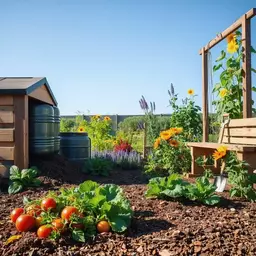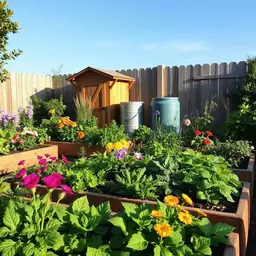Utilizing Native Plants
Boosts biodiversity and resilience, requiring less water and maintenance.
Gardening isn’t just a pastime; it’s a chance to make a difference in our suburban landscapes. By embracing sustainable practices, we can transform our neighborhoods into thriving ecosystems that promote health, biodiversity, and community connection. Ready to dig in? Let’s unearth the essentials of sustainable gardening!
Discover the essential techniques for cultivating eco-friendly gardens that benefit both your home and community.
Boosts biodiversity and resilience, requiring less water and maintenance.
Methods like rain gardens and drip irrigation help save water while gardening.
Utilizing organic practices and composting to enrich the soil naturally.
Support local ecosystems by designing gardens that attract beneficial wildlife.
Keeping our gardens thriving without harmful chemicals.
Gardening is more than just a hobby; it’s a powerful way to make our suburban communities greener and healthier! At Greener Suburbs, we believe that practicing sustainable gardening can transform our neighborhoods into vibrant ecosystems. By embracing eco-friendly methods, we not only enhance our environment but also create spaces where nature and community thrive together. For more insights on building a greener neighborhood, explore our community beautification project ideas.
Sustainable gardening practices are centered around using techniques that protect and preserve our local ecosystems. This means choosing methods that promote biodiversity, conserve resources, and minimize waste. With a little effort and creativity, we can cultivate gardens that not only look beautiful but also contribute to a healthier planet. How can we make our gardens more sustainable? Let’s dive into the key practices!
Sustainable gardening encompasses a variety of practices that focus on maintaining ecological balance while growing plants. Some core elements include:
By adopting these practices, we create a garden environment that reduces our carbon footprint and enhances our local biodiversity. It’s all about creating harmony between our gardens and the natural world around us!
Eco-friendly gardening offers numerous benefits to those of us living in suburban areas. It’s not just about pretty flowers; it’s about creating a thriving community. Here are some reasons to get excited about sustainable gardening:
Imagine stepping outside and seeing not just your garden but a beautiful patchwork of colorful blooms and buzzing bees all around! By working together with our neighbors and adopting these eco-friendly practices, we can create sustainable spaces that benefit everyone in our community. Learn more about effective waste management in suburban areas by checking out suburban strategies for smart waste.
Did you know? Incorporating companion planting in your garden can significantly enhance its sustainability. By planting certain species together, you can naturally deter pests, improve soil health, and promote plant growth. For example, pairing tomatoes with basil not only maximizes space but also enhances the flavor of your tomatoes while repelling harmful insects!
As we wrap up our exploration of sustainable gardening in suburban areas, it's vital to remember the essential practices that can help us create eco-friendly havens right at our homes. From understanding soil health to choosing the right plants, each aspect of sustainable gardening contributes to a healthier environment. By adopting these practices, we not only enhance the beauty of our neighborhoods but also foster a sense of community and responsibility toward our shared spaces. To delve deeper into creating green initiatives, explore starting your community green initiative.
Here’s a quick recap of the key techniques we discussed:
By focusing on these strategies, we can all contribute to a greener, more sustainable suburban landscape. So, let's keep these tips in mind as we embark on our gardening journeys!
Now that we’ve explored the importance of sustainable gardening practices, it’s time to take action! Starting small can lead to significant changes in your garden and community. You don't need a huge plot of land to make an impact—every little effort counts. Imagine transforming your front yard into a vibrant, eco-friendly space that not only enhances your property but also inspires your neighbors!
Here are some simple steps you can take to start implementing sustainable practices today:
Taking these steps not only benefits your garden but also helps foster a sense of community. Together, we can make our suburbs greener and more vibrant places to live!
As part of our journey toward sustainable gardening, it's crucial to connect with local resources and support networks. Organizations like Greener Suburbs are dedicated to helping residents engage in eco-friendly practices and build a stronger community. By tapping into these resources, you can access valuable information, participate in workshops, and even find gardening partners!
Here are ways to connect and find support in your sustainable gardening efforts:
With the right support and resources, you can take your gardening endeavors to new heights. So, let’s work together to cultivate a thriving, sustainable community! For more information on caring for your community and environment, consider joining our eco-friendly cleanup efforts.
Here is a quick recap of the important points discussed in the article:

 What if your next weekend could help restore local wildlife habitats while beautifying your communit
What if your next weekend could help restore local wildlife habitats while beautifying your communit
 What if your local business could lead the charge in transforming your community into a recycling po
What if your local business could lead the charge in transforming your community into a recycling po
 Gardening isn’t just a pastime; it’s a chance to make a difference in our suburban landscapes. B
Gardening isn’t just a pastime; it’s a chance to make a difference in our suburban landscapes. B
 Did you know that creating an eco-friendly garden can significantly enhance your home’s value and
Did you know that creating an eco-friendly garden can significantly enhance your home’s value and